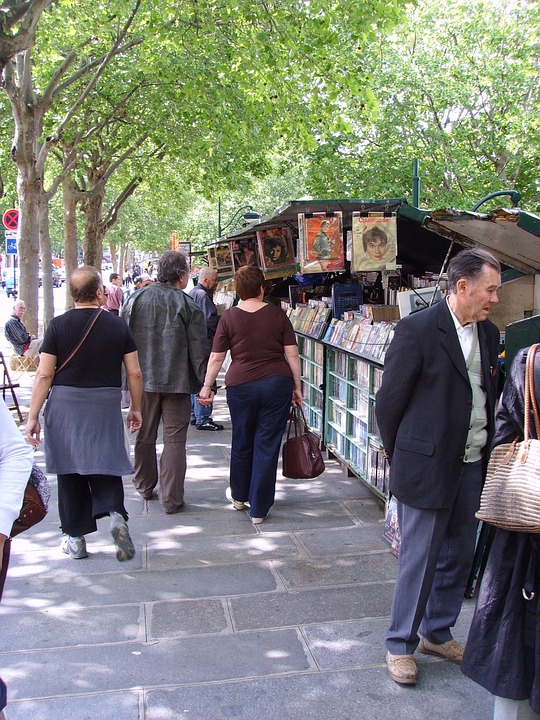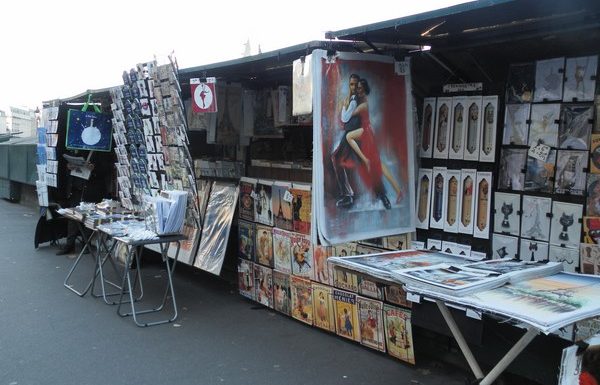Bouquinistes: discover the riverside booksellers of Paris

Since the 16th century, the booksellers, or bouquinistes, of Paris have been setting up their stalls along the river Seine.
A site now protected by UNESCO as part of French cultural heritage, the bouquinistes of Paris continue to sell rare editions, out of print magazines and collectors’ items from their green boxes – which were used as secret letterboxes by the French resistance during the war.
The Seine is described as the only river in the world that runs between two bookshelves, and Francois Mauriac considered the book boxes of the bouquinistes to be doors “for entering an enchanting world”.
At a time when bookshops are popping up all over Paris and translated literature is easily accessible, the bouquinistes are standing their ground; their stalls are crammed with delights that can only be found by rummaging through their shelves. Equipped with wooden foot-benches so that you can reach the very back of the boxes, there is no saying what you will unearth.
It is on one of the quays of the Seine that I met Colette, a round-faced and smiley Parisian working on her bouquiniste daughter’s stall. I bought a vintage copy of Alice in Wonderland, and Colette delighted in showing me around the box. However, she warned me straight away that “les bouquinistes are private people and don’t always appreciate journalists. And they definitely don’t want to be asked what they earn!”
The bouquinistes of Paris: a tumultuous history
From the 16th century onwards, makeshift bookstalls began appearing on the streets of Paris, with goods often spread out on blankets on the ground. It wasn’t long, however, before rules and regulations were imposed, and the Pont Neuf became a sort of battle-field between booksellers, the police force, and royal powers. In 1614, the bouquinistes won the right to legally sell from their stalls along the Pont Neuf and other quays, but after complaints from libraries in 1649, all mobile shops were suspended in that area.
It was Napoleon who finally officialised the title of bouquiniste, giving the bouquinistes of Paris equal status to other traders of the city.
The booksellers returned with the reign of Louis XVI and the Pont Neuf, in the Dauphine quarter, became a rendez-vous place for members of cultural and literary society. During the French Revolution from 1789 to 1795, the bouquinistes of Paris sold mainly revolutionary papers, political brochures and patriotic songs, but prospered when they began salvaging books pillaged from aristocratic libraries.
It was Napoleon who finally officialised the title of bouquiniste, giving the bouquinistes of Paris equal status to other traders of the city. From then on, the bouquinistes of Paris were allowed to set up the green book boxes one can see today in a dedicated area on the left embankment of the Seine, and licenses were printed and renewed each year from 10 October 1859.
The number of bouquinistes in Paris grew steadily, from just 69 in 1857 to 200 in 1900. In the 1930s the licence fee was abolished, meaning that the bouquinistes only had to pay tax. The dimension of each book box was regulated to a ten metre space but this changed during the German occupation, when bouquinistes were ordered to space out their boxes to allow for better surveillance and defence of the quay. This meant reducing the box spaces from ten to eight metres, which is still the case today.
In addition to this, only one box was allowed per household. Robert and Marie Francoise Betmont, a couple in love, were forced to live ‘in sin’ for numerous years as marriage would mean giving up one of their boxes and half of their joint income! Thankfully, this law was changed in 1993.
Rules and regulations
The contemporary bouquinistes of Paris pay neither rental fees nor tax and are UNESCO protected, but they must abide by strict measures imposed by the Mairie. Each bouquiniste may own up to 4 boxes, which must measure altogether no more than 8.6 metres in length. Only one of four boxes can be used to sell objects other than books, like photos, stamps or souvenirs. This is becoming a problem, as money made selling tourist souvenirs makes up a considerable part of many bouquinistes’ income.
No one can stop us from existing here.
Boxes must be open at least four days a week and the owner of each box must personally man his or her stall at least three days a week. On other days, they can be replaced by a family member or employee. The booksellers are allowed six weeks of annual leave and three months of sick leave, which can go up to a maximum of nine months in special cases. “We are tolerated by the Mairie because we are considered part of France’s patrimoine,” Colette tells me with a small smile. “No one can stop us from existing here.”
What does it take to be a bouquiniste in Paris?
This is a job that is more popular than you would expect, and the Mairie examines hundreds of CVs when a space along the Seine becomes vacant. A passion for literature is a must and candidates must also be able to specify what kind of books they wish to sell. While many bouquinistes have deliberately chosen this profession, some have inherited the stalls from family members. When I spoke to Colette, whose daughter has been a bouquiniste for 28 years, she told me: “You have to be passionate—you have to really want this life. Sitting in front of your stall, all day and all year round, it can get lonely.”

There is an authenticity here, a sense of simplicity that can only be found among street stalls selling stories. Colette records each purchase in a small notebook, and when I hand over the money for my copy of Alice in Wonderland, she slips the note into a paper envelope.
The stall is a mix of vintage feminist pamphlets called ‘Le Torchon’, books with worn covers and photography by Robert Doisneau. A nearby stall reveals other treasures: leather-bound tomes in bright colours with intricately decorated spines, full of ideas about human-sciences and philosophy.
When I asked Colette if large bookstores or online book dealers have created competition within the world of the bouquinistes, she was unfazed. “Tourists go to Shakespeare and Co’ for books. They’re not very interested in what we have, except for our tiny collection of English books and the souvenirs we sell. Those who come to us usually know what they are looking for”, she says, “but my daughter’s stall is a place where you can fall upon a wonderful book completely by chance.”
There is an authenticity here, a sense of simplicity that can only be found among street stalls selling stories.
Colette’s daughter sources most of her books from flea markets. “She sells things you can’t find in modern bookstores,” Colette says, “like out-of-print copies, old newspapers and vintage magazines.” Theirs is a creative family. “She got her love of books from her father,” Colette tells me. “It’s about the only thing she got from him! Her daughter—my granddaughter—is the same and is studying for a degree in graphic design in Brussels.”
In another interview, bouquiniste Gilles says that his profession allows him to challenge stereotypes. “Young people don’t read?” he says. “I have many young people among my clientele. North-Americans have little culture? Some come looking for classic works that many French people have never read or heard of!” Books are usually priced at a minimum of eight euros, but can go up to around forty. Paintings can sell for much more.
I was fascinated by the bouquinistes of Paris when I saw them for the first time, because what could sound better to a literature lover than selling and discussing books all day? The quays of the river Seine, bouquiniste territory, are bustling places in the 6th arrondissement. Here, the presence of the written word seems to hang in the air. “People come here looking for Moliere, Aragon, Quenot and Proust. They’re looking for the French language,” Colette told me before I left. And that is precisely what the bouquinistes of Paris have to offer—preservation of the love of reading, and the French language at its best.
Have you ever visited the bouquiniste stalls in Paris? What treasures did you find? Let us know in the comments below!
Image credits:
1-4. © Stephanie Williamson
5. Book Market, via pixabay.
6. © Stephanie Williamson











Excellent, interesting and rare article about the bouquinistes in Paris!